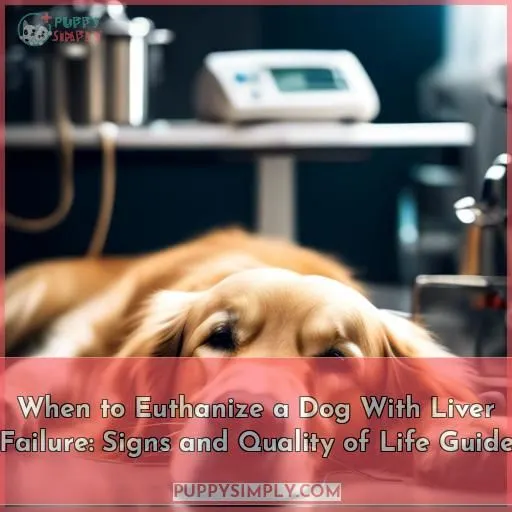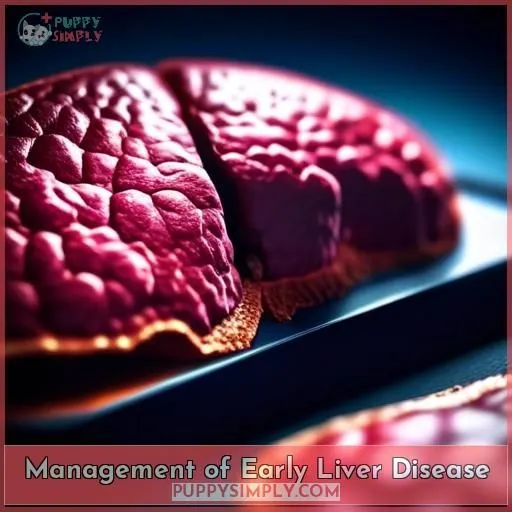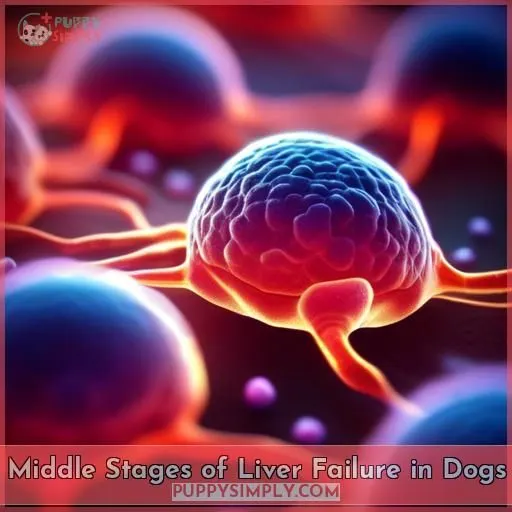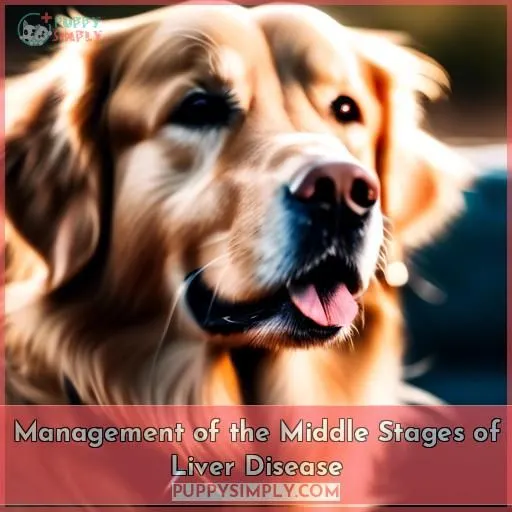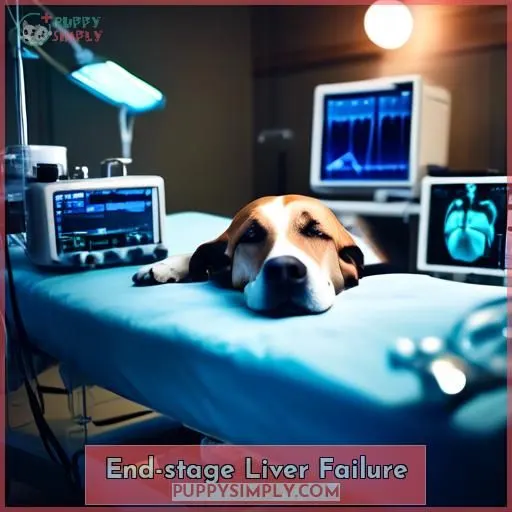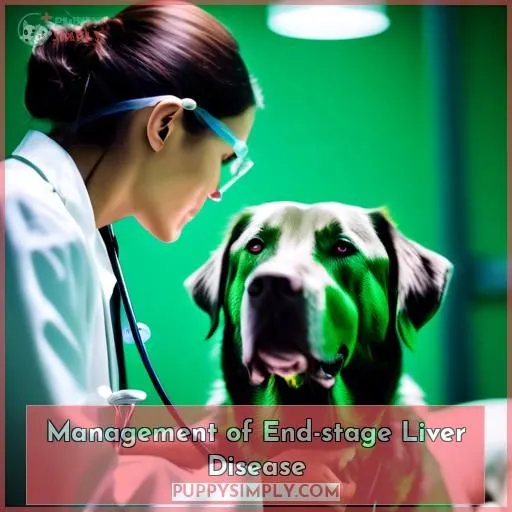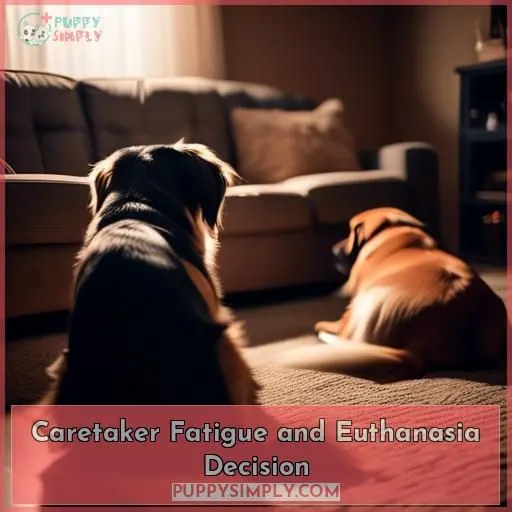This site is supported by our readers. We may earn a commission, at no cost to you, if you purchase through links.
You’ll know it’s time to euthanize a dog with liver failure when their quality of life deteriorates significantly.
Watch for signs like chronic nausea, pain, disinterest in favorite activities, and an inability to enjoy life.
While early interventions like diet changes and medication may help initially, end-stage liver disease eventually causes unrelenting discomfort.
Prioritize your dog’s comfort and discuss quality of life assessments with your vet when determining when to euthanize.
This heartbreaking decision weighs heavily, but a peaceful ending prevents unnecessary suffering for a cherished companion.
Guidance on recognizing declining quality of life awaits.
Table Of Contents
- Key Takeaways
- When to Euthanize a Dog With Liver Failure?
- Early Liver Failure in Dogs
- Management of Early Liver Disease
- Middle Stages of Liver Failure in Dogs
- Management of the Middle Stages of Liver Disease
- End-stage Liver Failure
- Management of End-stage Liver Disease
- Determining the Right Time for Euthanasia
- Assessing Your Dog’s Quality of Life
- Caretaker Fatigue and Euthanasia Decision
- Consulting Your Veterinarian
- Frequently Asked Questions (FAQs)
- What are the common signs of liver failure in dogs?
- How can I assess my dog’s quality of life during liver disease progression?
- What should I consider when deciding to euthanize a dog with liver failure?
- How can I manage my own emotional well-being while dealing with my dog’s liver disease?
- What resources are available for pet owners dealing with the emotional impact of euthanasia?
- Conclusion
Key Takeaways
- Monitor your dog’s quality of life closely, looking for signs of chronic nausea, pain, disinterest in favorite activities, and an inability to enjoy life.
- In the early stages of liver disease, manage your dog’s condition with dietary changes, exercise, and medication to support liver function.
- Regularly assess your dog’s quality of life and work closely with your veterinarian to determine the appropriate course of action, whether it’s managing symptoms, providing supportive care, or considering euthanasia when necessary.
- In the end stages of liver failure, assess your dog’s quality of life using a scale or tools like the Quality-of-Life Assessment Tool or Lap of Love, and consider palliative care, liver transplantation, in-home euthanasia, or organ donation.
When to Euthanize a Dog With Liver Failure?
Deciding when to euthanize a dog with liver failure involves observing for signs of severe discomfort, such as loss of appetite, vomiting, jaundice, lethargy, and seizures, which indicate a significantly diminished quality of life.
It’s a compassionate choice made to alleviate suffering when the dog’s condition is beyond medical help.
Early Liver Failure in Dogs
Early liver failure in dogs can be a challenging condition to detect due to its subtle symptoms. In the early stages, dogs may not exhibit any noticeable symptoms, with elevated ALP being the only indication of liver dysfunction. However, as the disease progresses, dogs may start to show signs such as lethargy, low appetite, fatigue, and weight loss. It’s essential to maintain regular veterinary check-ups to monitor your dog’s liver health and catch any issues early on.
While it’s crucial to understand the early symptoms of liver failure in dogs, it’s equally important to know how to manage the disease in its early stages. This will be discussed in the next subtopic.
Management of Early Liver Disease
In the early stages of liver disease in dogs, your pet may not show any symptoms.
However, blood tests can reveal high levels of ALP, indicating potential liver damage.
At this stage, management involves dietary changes, exercise, and medication to support liver function.
Regular monitoring is crucial to assess the progression of the disease and determine the appropriate treatment.
The prognosis for early-stage liver disease can vary, with some dogs living for years, while others may progress to end-stage liver failure.
It’s essential to work closely with your veterinarian to develop a management plan tailored to your dog’s needs.
Middle Stages of Liver Failure in Dogs
In the middle stages of liver failure in dogs, your pet may experience a loss of appetite, fatigue, and bruising. Your dog may also itch and lose hair, which can be uncomfortable for them. At this stage, it’s crucial to work closely with your veterinarian to manage your pet’s symptoms and maintain their quality of life.
To better understand the progression of liver disease in dogs, let’s delve into the table below:
| Stage | Signs | Management |
|---|---|---|
| Early | Lethargy, loss of appetite, vomiting | Treatment and monitoring |
| Middle | Loss of appetite, fatigue, bruising, itching | Supportive care, dietary changes |
| Late | Neurological issues, jaundice, abdominal distension | Palliative care, euthanasia |
As your dog progresses through the stages of liver failure, it’s essential to assess their quality of life regularly. Your veterinarian can help you determine the right course of action, whether it’s managing symptoms, providing supportive care, or considering euthanasia when necessary.
In the middle stages, your dog may still be able to enjoy a good quality of life with the right care. However, it’s important to remember that each dog’s experience is unique, and the progression of liver failure can vary greatly depending on the underlying cause and the individual dog’s response to treatment.
Consulting your veterinarian is invaluable during this process. They can help you understand your dog’s condition, discuss treatment options, and assess your dog’s quality of life. Together, you can make informed decisions about your pet’s care and well-being.
Management of the Middle Stages of Liver Disease
As your dog’s liver disease progresses, managing its condition becomes increasingly important. In the middle stages, supportive care strategies can help your pet maintain a good quality of life.
- Monitoring disease progression: Regularly check your dog’s symptoms and blood tests to assess the progression of the disease. This will help you and your veterinarian make informed decisions about the best course of treatment and when to consider euthanasia.
- Medication management: Administer prescribed medications as directed by your veterinarian. These may include antiemetics, drugs for hepatic encephalopathy, or other liver-supporting medications.
- Nutritional support: Feed your dog a specialized diet that’s low in protein, fat, and copper, and high in antioxidants and other nutrients that support liver function. This may involve a prescription diet or home-cooked meals with appropriate ingredients.
- Quality of life assessments: Regularly evaluate your dog’s quality of life using a scale such as the HHHHHMM scale, which assesses factors like hunger, hydration, hygiene, happiness, and pain.
- Euthanasia considerations: If your dog’s symptoms become unmanageable or its quality of life is significantly reduced, euthanasia may be the kindest option. Consult with your veterinarian to discuss the best time for this decision.
End-stage Liver Failure
End-stage liver failure can be a daunting prospect for dog owners. It’s crucial to assess your dog’s quality of life and consider palliative care or assisted dying when the prognosis is poor.
- Quality of Life Assessment: Evaluate your dog’s quality of life using a scale or tools like the Quality-of-Life Assessment Tool or Lap of Love. This will help you objectively measure your pet’s well-being and determine when it’s time for euthanasia.
- Palliative Care: In the early and middle stages of liver disease, your veterinarian can discuss treatment options and supportive care. However, in the end stages, palliative care may be the best choice to ensure your dog’s comfort and dignity.
- Organ Donation and In-Home Euthanasia: If your dog’s condition is severe and you’re considering euthanasia, discuss the possibility of organ donation. Additionally, in-home euthanasia may be an option for those who prefer their pet to pass away in a familiar environment.
Management of End-stage Liver Disease
Managing end-stage liver disease in your furry friend is like walking a tightrope, balancing between hope and comfort. It’s a time when every moment counts, and your dog’s care becomes a labor of love.
You might explore liver transplantation, but it’s a rare beacon on a foggy night. More often, you’ll wrap your dog in the warm embrace of palliative care, ensuring their days are as comfortable as possible.
| Palliative Care | Alternative Treatments |
|---|---|
| Pain management | Acupuncture |
| Fluid therapy | Herbal remedies |
| Nutritional support | Special diets |
Nutrition management is key; think of it as the fuel that keeps their tail wagging. Hospice care is another avenue, offering a sanctuary for those final, precious moments. And while alternative treatments like acupuncture mightn’t be a cure-all, they can add a sprinkle of relief to your dog’s routine.
Determining the Right Time for Euthanasia
Determining the right time for euthanasia is one of the most challenging decisions a pet owner can face, especially when dealing with a progressive disease like liver failure in dogs. While early and middle-stage liver disease can be managed, the end stages can be difficult to navigate. Euthanasia may be suggested when symptoms become unmanageable, but it’s not always clear when that point arrives.
Your veterinarian is an invaluable resource in this process. They can discuss treatment options, supportive care, and the prognosis for your dog. They can also help you assess your dog’s quality of life, which is crucial in the late stages of liver disease. This assessment includes questions about eating, drinking, pain, and participation in daily activities.
Euthanasia may be considered when your dog’s quality of life is no longer acceptable. This could be due to intense pain that doesn’t respond to treatment, severe organ failure, or a combination of conditions that cause suffering. It’s essential to consider your dog’s overall well-being and whether they’re experiencing pain, difficulty eating, or a significant decline in their ability to function.
In the case of liver failure, euthanasia may be the kindest choice when your dog’s pain and discomfort can no longer be managed. This decision is often made in the hospital or at home, depending on your dog’s condition and your family’s preference.
Assessing Your Dog’s Quality of Life
Assessing your dog’s quality of life is crucial in the later stages of liver disease. This involves evaluating factors such as pain, hydration, nutrition, exercise, and environmental enrichment.
If your dog is experiencing pain that cannot be managed, it may be time to consider euthanasia. Ensuring your dog is well-hydrated and receiving appropriate nutritional support is essential.
Exercise guidelines should be tailored to your dog’s condition, and environmental enrichment can help maintain their mental stimulation and overall well-being.
It is important to remember that each dog’s experience with liver disease is unique, and the right time for euthanasia can be challenging to determine. Consulting with your veterinarian can provide valuable insights into your dog’s condition and help you make informed decisions about their care.
Caretaker Fatigue and Euthanasia Decision
As a caregiver, the decision to euthanize your beloved pet is one of the most difficult you’ll ever face. The emotional impact of this decision can be overwhelming, and it’s essential to have a support system in place during this challenging time.
- Prepare yourself: If your pet is suffering from severe medical issues and a noticeable decline in quality of life, it may be helpful to prepare yourself for the possibility of euthanasia. Consult with your veterinarian to discuss your pet’s condition, treatment options, and potential outcomes.
- Enhance your pet’s last days: If you know your pet’s last days are approaching, make the remaining time special by staying close to them and offering reassuring words and touch if they’re anxious.
- Grieve: Allow yourself to experience the grief process, which isn’t linear and will progress in its own time. It’s normal to feel a range of emotions, including denial, anger, guilt, sadness, and depression.
- Seek support: Talk to a counselor or join a support group for pet owners who’ve experienced the loss of a pet after euthanasia. They can provide guidance and understanding during this difficult time.
- Consider a new pet: When you feel ready, you may be interested in adopting a new pet. While a new companion can never replace the one you lost, they can bring new love and happiness into your life, creating a different but equally special bond.
Consulting Your Veterinarian
When it comes to managing liver disease in dogs, consulting your veterinarian is crucial. Your vet can discuss treatment options, supportive care, prognosis, and palliative care options. They can also help you assess your dog’s quality of life, which is a vital factor in late-stage liver disease.
Here are some key points to consider when consulting your veterinarian:
- Prognosis discussions: Your vet can provide insights into the potential outcomes of your dog’s liver disease, based on the severity of the disease and the underlying cause. They can also discuss the possibility of liver regeneration and repair.
- Treatment options exploration: Your vet can recommend specific treatments based on your dog’s condition. These may include medications, dietary changes, and supportive care. They can also help you understand the potential side effects and risks associated with these treatments.
- Palliative care options: If your dog’s liver disease is advanced, your vet may discuss palliative care options to help manage symptoms and improve your dog’s quality of life. This may include pain management, nutritional support, and monitoring for complications.
- Quality of life assessments: Your vet can help you assess your dog’s quality of life, which is a crucial factor in determining the right time for euthanasia. They can provide guidance on how to measure your dog’s well-being and when it may be time to consider euthanasia.
Frequently Asked Questions (FAQs)
What are the common signs of liver failure in dogs?
Key signs of liver failure in dogs include jaundice, lethargy, vomiting, diarrhea, loss of appetite, and weight loss. Monitor your pup closely and consult your vet if concerned.
How can I assess my dog’s quality of life during liver disease progression?
The sun sets on life’s journey, treasure each day like a wildflower – assess joy in tail wags, interest in treats, and peaceful rests. When pain exceeds peace, release with kindness.
What should I consider when deciding to euthanize a dog with liver failure?
Consider your dog’s quality of life, pain management, and your ability to provide adequate care. Consult your vet, but ultimately, an agonizing or rapidly declining condition may warrant euthanasia as a humane choice.
How can I manage my own emotional well-being while dealing with my dog’s liver disease?
1 in 4 pet owners struggle with guilt when their dog is terminally ill. Be gentle with yourself – lean on loved ones, join support groups, and consider counseling to navigate this heartbreaking journey compassionately.
What resources are available for pet owners dealing with the emotional impact of euthanasia?
Seek pet loss support hotlines and online forums where you can share your feelings with others who understand your grief. A compassionate vet can also provide guidance on coping during this difficult time.
Conclusion
Lulu, your beloved golden retriever, is struggling with end-stage liver failure. Despite your best efforts, her quality of life has diminished. When deciding when to euthanize a dog with liver failure, trust your instincts and vet’s guidance. If Lulu can no longer enjoy life due to unrelenting discomfort, euthanasia may be the kindest option to prevent unnecessary suffering.

